DSA’s budget crisis has been a long time coming
The sick man of the socialist movement

The January 14, 2024, meeting of the Democratic Socialists of America (DSA)’s national leadership, the National Political Committee (NPC), must have been a doozy. At that meeting, the NPC was forced to reckon with a budget deficit that threatens to bankrupt the organization. The NPC posted a “Treasury Report & Short Briefing” on the DSA Discussion Board outlining the magnitude of the crisis:
In a worst-case scenario, with all funding requests approved, we could face a critical financial situation as early as August 2024, where meeting our obligations, including those to our staff, becomes a day-to-day challenge, potentially leading to the closure of the organization.
Two days later, DSA National Director Maria Svart, in the position since 2011, announced her resignation. DSA Operations Director Kristina Sepulveda was Svart’s chosen successor but resigned on January 25, less than two weeks later. Sepulveda desired debate around her candidacy to be confidential and quit when minutes were to be published for the membership.
On January 18, Bread & Roses’ The Call explained that DSA projected “$5 million in income and $7 million in expenses”—a $2 million deficit. They called for a $500,000 cut in staff expenses to begin to address the deficit. That same day, the Socialist Majority Caucus (SMC) responded on their blog, The Agitator, with similar details about the particulars of the deficit. They emphatically rejected staff layoffs in favor of other cuts (suspending stipends, reducing chapter dues-share, cutting travel, printing, and technology, shuttering the national office,and more). On January 20, the Marxist Unity Group posted on their website in support of Bread and Roses’ proposals and opposed to SMC’s suggested cuts. On January 21, the Young Democratic Socialists of America, DSA’s youth organization, issued a public protest of cuts that would affect them.
The ensuing Twitter battles have been brutal. Anyone familiar with DSA will recognize the themes: “posting discipline” (discouraging public discussion of DSA business), accusations of being anti-union in relation to discussing laying off staff, charges of conspiratorial factionalism, and so on.
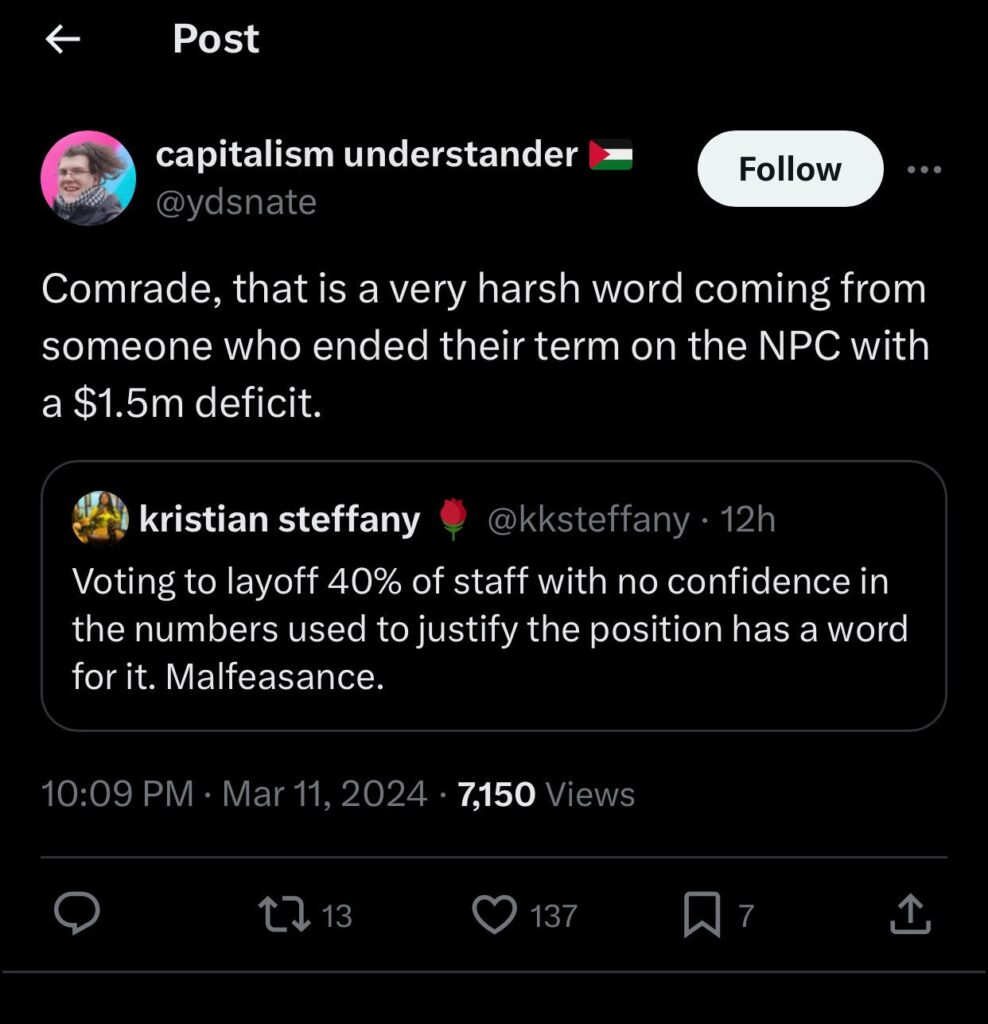
On February 20, the NPC passed a “Resolution to Initiate the Process of Laying Off Staff Positions,” pledging to begin layoffs by April 15. On March 8, the Red Star caucus posted an article on their website, “How Red Star is Thinking About Layoffs.” They wrote,
Our philosophy here is to cut deep and cut once: the org needs to make layoffs, and in our view, the goal is to do so to a level that secures DSA National’s continued solvency through this NPC term and at least 6 months into the next one. This is why Red Star proposed and the NPC passed a target of maintaining sufficient cash reserves through December 2025.
The NPC began a process of voting on spending cuts from March 8 through 11, 2024. This included the “Resolution to Achieve Fiscal Sustainability Through Staff Layoffs and Union Engagement”, which committed to laying off twelve staff members. The resolution cites “the need to reduce its annual operating expenses by approximately $610,038.90 for 2024 and $1,183,043 for 2025 as part of a comprehensive strategy to address the current budget deficit of $1,240,201.”
On March 9, in response to the resolutions the DSA’s staff union tweeted “Fuck 12” – inappropriately alluding to the phrase used by protestors of racist police murders. The staff union posted on the Discussion Board rejecting the layoffs and calling for members to intervene on their behalf via a petition, attendance at NPC meetings, and increasing dues donations.
Statements that this decision to lay off staff is in response to a democratic mandate or is the only choice of an exhausted budget should not be taken seriously…We encourage our members to let the NPC know how important you believe DSA Staff, and the work we do, is to the success of this organization, and call out their determination to reject so many alternative cuts while they maximize the firing of union staff.
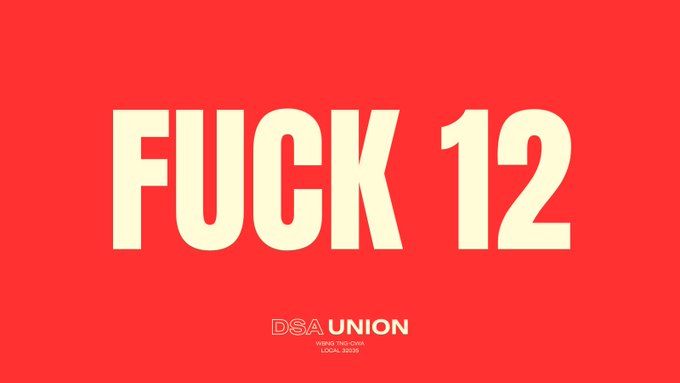
In sum, over a million dollars of expenses were cut, including twelve of approximately thirty of DSA’s staff. Even still, DSA will continue to run a deficit of somewhere between $800,000 and $925,000 annually.
Money Talks
What is shocking is how DSA has come to the brink of bankruptcy—and how little was done to prevent it. Serious discussion of the loss of tens of thousands of members began in 2023, although the organization’s growth had already peaked in 2021. According to that Growth and Development Committee (“GDC”) report, the implications of this loss were such that 2022 “mark[ed] a 14% decrease” in membership dues (income) compared to the previous year, or about $900,000. Despite this, the 2021 NPC budgeted an increase in spending by nearly $2 million: “the budget anticipated an increase of $700,000 over 2022.” This is rather like poking a second hole in the boat so the water has somewhere to go.
But dues income did not come back up to recover the loss—it dropped further as more people left DSA. According to the GDC report, “At the end of 2023, our revenue was approximately $700,000 less than 2022, with spending exceeding the previous year by $1.6 million.” Dues are projected to fall by another $240,000 in 2024.
As this was happening, DSA held its national convention in August 2023. The deficit was acknowledged in the Convention’s Financial Report, but somehow this was not addressed as a priority issue among delegates. Instead, as they had at previous conventions, delegates passed numerous resolutions calling for additional staff and spending. Socialist Majority even went so far as to argue for doubling the staff from 30 to 60.
In theory, DSA had the information it needed about the situation early enough to respond. Declining membership figures were noted in 2021 and reported again during spring financial reports. DSA had delegated conventions in 2021 and 2023 to have a frank discussion and democratically address the situation before it spiraled out of control. However, the problem was dismissed as something that zealous fundraising and gamified membership drives could solve. The issue was deferred until it was simply impossible to ignore.
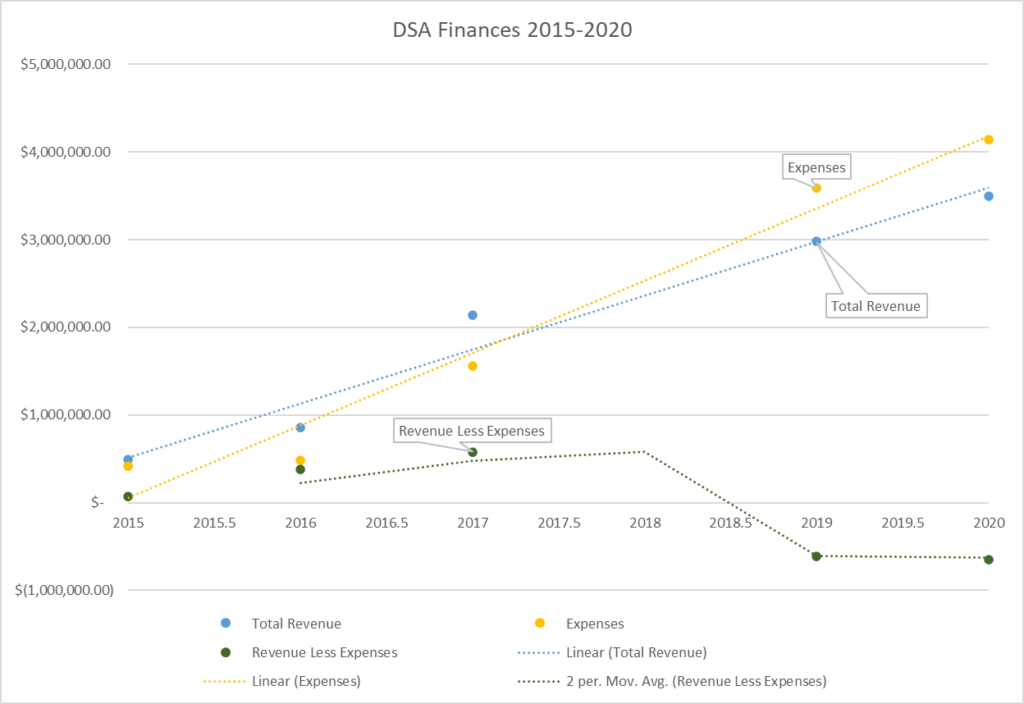
Triumphalism and Closed Doors
It is worth taking a moment to ask how this happened, particularly in a group that prizes McAlevey-esque “good organizing” and scientific socialism. How does an organization choose to ramp up its spending year after year even when its own data show declining membership figures and dues income?
A basic survey in accounting would be enough to know that when your income drops, your expenses generally should too. Going a little deeper, forecasting would give a sense of projected growth or contraction using data points to anticipate possible scenarios for the future. When the numbers keep going down, it stands to reason that this is a trend that will continue absent some major shift.
And since this is a political organization and not a business, paying attention to political events and factors should be part of this calculation. It was commonly understood that there was a relationship between the Trump election, Sanders’ campaign, and DSA’s ballooning growth. Likewise, when Biden was elected these two external factors ceased to exist and we see membership rolls hit their peak and begin to fall at the beginning of 2021. (This is to say nothing about factors internal to DSA and within its control that would have bearing on membership.) But instead of adjusting, DSA’s leadership doubled down.
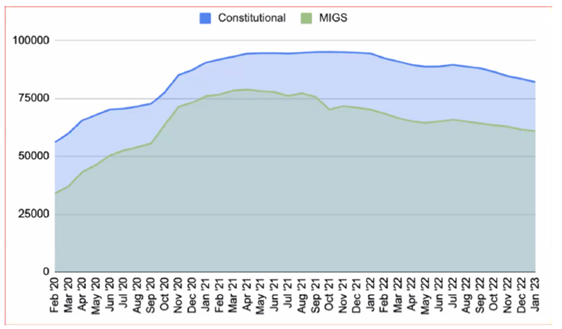
When decisions are made in spite of the evidence, some idea or story has to be deployed to allow two incompatible positions to coexist. Basically, DSA’s political leadership believed that (or at least acted as though) the organization was going to continue to grow forever even though the numbers told them they were shrinking and the political situation that propelled them had disappeared. The figures showing decline were either suppressed, hand waived as a temporary setback, or rationalized as evidence that there was insufficient support for the leadership and staff.
During mid-2023, DSA’s Socialist Forum posted an article “Is DSA Really in Crisis?” Author Emmett McKenna’s answer unsurprisingly was “No,” and McKenna articulated the narrative in no uncertain terms:
Contrary to internal skepticism, DSA is in a much stronger position today than ever before. We are the most influential socialist organization in the United States in nearly a century. Where other US socialist organizations faltered, DSA has succeeded due to a flexibility that has allowed us to participate effectively in mass politics… These persistent so-called crises do not reflect the actual state of affairs in our organization, but by creating an atmosphere of internal disorder, they threaten to hinder DSA’s ability to grow into a mass movement and to return us to the margins of political life.
Let’s call this “DSA Triumphalism”: Claiming to have overcome the historic weakness of the Left, sections of the organization declared DSA’s superiority over other socialist projects, rejected the material dynamics that had led to the marginalization of the Left and which returned in force post-2021-all while policing the bounds of debate within the organization and projecting unlimited growth. DSA Triumphalists have no reservations about declaring what is good for the entire “working class,” particularly as it relates to Democratic Party elections. Somehow, at the same, time DSA is proclaimed to be the best and strongest socialist organization surpassing all others while being so fragile that any real scrutiny of its affairs would destroy the organization. Of course, McKenna was dead wrong – not only was there a crisis, but it is potentially a terminal one.
But the subjective factors can only be a partial explanation. This kind of delusion takes hold because of the larger problem of DSA’s governance. All the major decisions of the organization are made behind closed doors, where factional politics played an outsized role on the leadership bodies in isolation from the will of the membership. DSA members have no control over their organization’s budget, even at their biannual conventions (“the highest body of the organization”). Budget and staffing have been reserved for the NPC formally, but were too often siloed off to a fraction of the leadership along with staff.
To the extent that the Convention was able to pass resolutions with financial implications, in practice these became advisory only. In the 2019, 2021, and 2023 Conventions, delegates passed resolutions that would have required a geometric increase in funding. It wasn’t that delegates were financially illiterate—this was a kind of adaptation to an undemocratic system. Because the Conventions did not decide how to allocate resources democratically, it was understood that the NPC was the final authority and would adjudicate which (if any) resolutions would be pursued and ultimately funded. Thus, the aim of many DSA caucuses became to demonstrate that their resolutions had the greatest support and then to engage in factional political maneuvering at the NPC-level post-convention to secure the funds.
“Rank-and-file” DSA members who were not attached to leadership factions became discouraged at this process, demonstrated by the plummeting number of resolutions submitted to each convention. In real terms, separating the budget process from the convention hollowed out the democratic process and reduced the convention’s function to being a vehicle for NPC elections and social networking. The outcomes of convention resolutions had little bearing on the prerogatives of the leadership layer when they steered the organization in the ensuing two years.
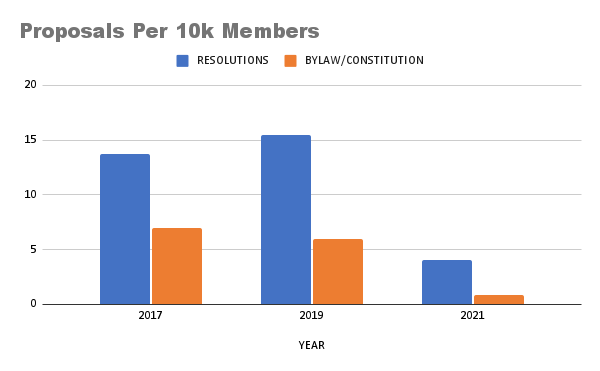
The budget process itself is officially charged to the NPC. The NPC creates a subcommittee, including staff, who craft a budget and return it for a vote. Former NPC-member Jenbo explained that the full leadership did not receive line item financials. In effect, the budget process was insulated not just from the membership, but even from parts of the official leadership. This starts to explain how the situation could become so disastrously out of control.
Attempts to correct the course were met with hostility, which deepened the crisis. NPC member Kara H, who raised alarm about the budget in 2023, was disciplined by other members of the leadership for doing so.
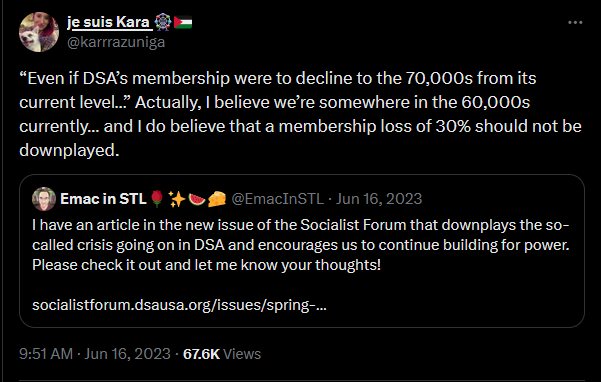
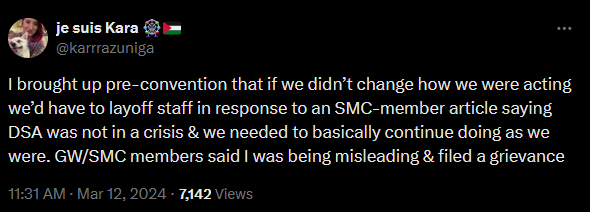
Without democratic governance, the basic self-correcting mechanisms of an organization are disabled. There is some irony in DSA members taking inspiration from the United Auto Workers (UAW) reform movement. Reform in the union was propelled by the historic UAW leaderhip’s ultra-centralization, which enabled the worst kind of corruption and spelled disaster for its members. That situation was resolved externally by the federal government’s intervention—the structure of the union was so thoroughly controlled that reform movements for decades were unable to change the UAW. DSA is not a union, but it is an interesting corollary. The Labour Party likewise resisted the will of its membership amid the influx of young radicals under Corbyn, like it has for generations before. No external force exists that is going to force DSA to be reformed – we would not want some kind of government intervention, but an ossified leadership structure is seriously resilient in the absence of member democracy.
The political moment had clearly passed, but DSA lived beyond its means as part of its self-delusion. Reality has caught up to the organization, and it simply is not possible to continue: Approximately half the staff will be laid off, the print publication will move mostly online, funds for education and organizing will be diminished, and chapter dues shares are at stake. Distributing a portion of dues money to chapters is the last thread tying them to DSA: If DSA National halts its dues share, there will be little left convincing local activists to maintain their affiliation.
There’s nothing to celebrate in the decline of the organization. In its best years, DSA was able to unite fragmented parts of the US Left and bring them into a single organization under the banner of socialism. Its weight had a gravitational pull on others, bringing them into its orbit if not directly into the organization. This was exciting and challenging – with the early DSA years having something of a social movement character in its creativity and infectious energy. Watching the demise of the organization now has greater implications than the politics within DSA itself — the disorganization of the Left amidst ever greater crises, genocide, environmental destruction, and advance of the Far Right. All of us should learn from these limitations and mistakes as we continue the project of building a force to transform society.
Featured image credit: Cory Doctorow; modified by Tempest.
Opinions expressed in signed articles do not necessarily represent the views of the editors or the Tempest Collective. For more information, see “About Tempest Collective.”
Categories
We want to hear what you think. Contact us at editors@tempestmag.org. And if you've enjoyed what you've read, please consider donating to support our work:
DonateAndy Sernatinger View All
Andrew Sernatinger is a Teamster and labor activist in Madison, Wisconsin. He is a member of the Tempest Collective and has written for New Politics, International Viewpoint, Jacobin, and In These Times .
